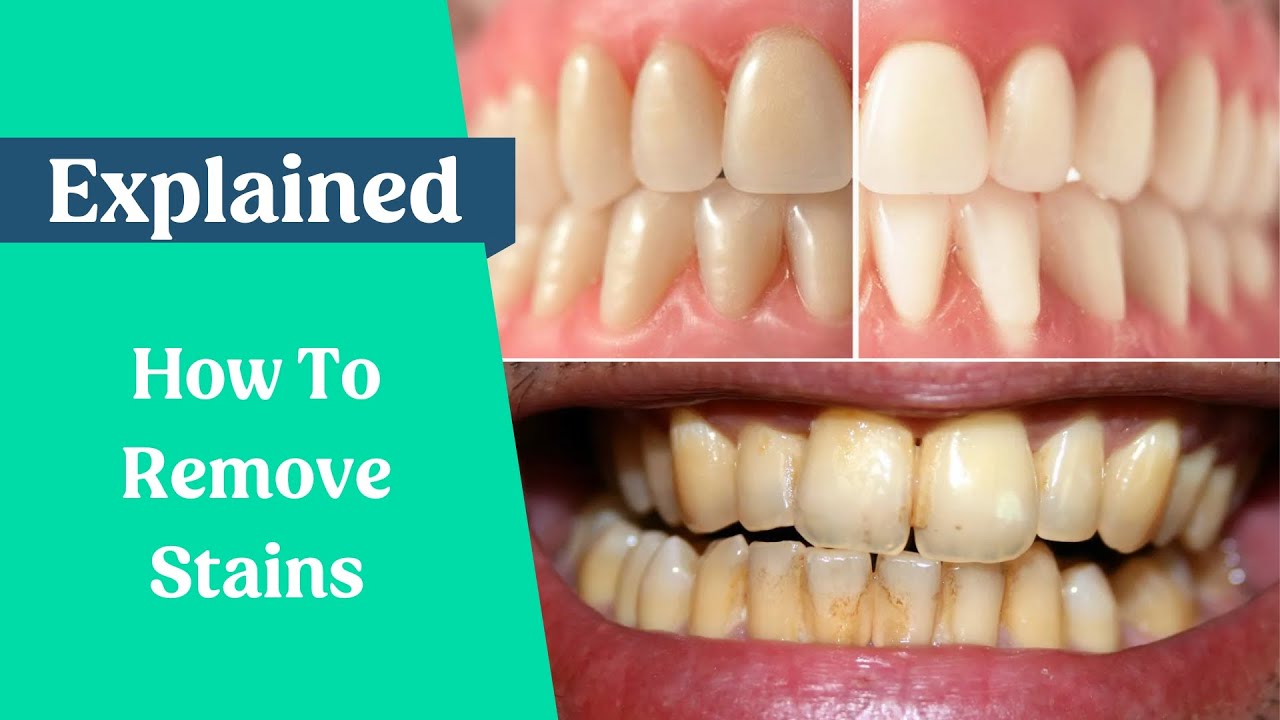We’ve all been there—caught in the mirror, frowning at our reflection, wondering why our pearly whites have lost their luster. Yellow teeth can be a real confidence killer, but the good news is that you don’t always need a dentist's chair to bring your smile back to life! This blog will guide you through effective tips and techniques to clean yellow teeth at home. So, let’s get started on the journey to a brighter smile without breaking the bank!
Understanding the Causes of Yellow Teeth

Before we dive into solutions, it's essential to understand what causes those unsightly yellow stains on your teeth. Knowing the culprits can help you take proactive steps to prevent and treat the issue. Here are some common causes:
- Dietary Choices: Foods and beverages rich in pigments can lead to staining. Regular consumption of items like:
- Coffee and tea
- Red wine
- Colas and sodas
- Certain fruits like berries
- Tobacco Use: Smoking or chewing tobacco is infamous for yellowing teeth. The nicotine and tar from tobacco can stain your teeth over time.
- Poor Oral Hygiene: Neglecting daily brushing and flossing allows plaque to build up and can lead to discoloration. A lack of regular cleanings can worsen the situation.
- Age: As we age, the enamel on our teeth can wear down, exposing the yellowish dentin underneath. This natural aging process can lead to a duller smile.
- Medications: Certain medications, especially tetracycline antibiotics, can cause staining in developing teeth. In some cases, mouth rinses containing chlorhexidine or cetylpyridinium chloride can also lead to discoloration.
Understanding these causes is the first step towards improving your dental health and restoring your smile. By identifying the sources of discoloration, you’ll be better equipped to make changes that lead to brighter teeth!
Natural Remedies for Whitening Teeth
When it comes to whitening teeth naturally, there are several remedies that you might already have at home! These methods can be effective, affordable, and quite simple to incorporate into your routine. Let’s explore some popular natural remedies:
- Baking Soda and Hydrogen Peroxide: This dynamic duo is well-known for its whitening properties. You can create a paste using 1 tablespoon of baking soda and 2 tablespoons of hydrogen peroxide. Gently brush your teeth with it a couple of times a week, but be cautious not to overdo it, as it can erode enamel if used too frequently.
- Apple Cider Vinegar: Thanks to its acidic nature, apple cider vinegar can help remove stains. Mix it with water, dilute it accordingly, and use it as a mouthwash. However, avoid direct application as it can harm your enamel.
- Coconut Oil Pulling: This ancient Ayurvedic practice involves swishing coconut oil in your mouth for 10-20 minutes. It not only helps in whitening but also promotes overall oral health by reducing harmful bacteria.
- Activated Charcoal: Activated charcoal has become a trendy ingredient for natural teeth whitening. Make a paste with coconut oil and apply it to your teeth, leave it for a few minutes, then rinse thoroughly. Just remember, moderation is key!
- Strawberries: This delicious fruit contains malic acid, which can help lift surface stains. Mash a couple of strawberries and mix them with baking soda, then apply the paste to your teeth for about 5 minutes before rinsing.
While these remedies can be beneficial, it's essential to understand that results may vary and patience is key. Always consult with your dentist if you’re unsure about any natural treatments!
Oral Hygiene Practices to Maintain Whiteness
Now that you've worked on whitening your teeth naturally, it’s crucial to adopt oral hygiene practices that help maintain that brightness. After all, what’s the point of white teeth if they're back to yellow soon after? Here are some effective practices that can help you keep your smile shining:
- Brush Twice Daily: It may seem obvious, but brushing your teeth twice a day with a fluoride toothpaste removes plaque and surface stains effectively. Be sure to brush for at least two minutes each time!
- Floss Regularly: Flossing removes food particles and plaque from between your teeth where your toothbrush can’t reach. Make it a habit to floss at least once a day.
- Use a Whitening Toothpaste: Consider incorporating a whitening toothpaste into your routine. These are specially formulated to help remove stains and maintain whiteness.
- Limit Stain-Causing Foods: Consuming foods like coffee, red wine, or certain sauces can lead to discoloration. If you indulge, try to rinse your mouth with water afterward.
- Stay Hydrated: Drinking plenty of water throughout the day not only ensures that you remain hydrated but also helps wash away food particles that can lead to staining.
By developing these oral hygiene habits, you ensure that your smile not only looks great but stays healthy too. After all, a bright, white smile is not just about appearance; it’s about confidence and overall oral health!
5. Dietary Changes to Prevent Yellowing
When it comes to maintaining that pearly-white smile, what you eat plays a significant role. Here are some dietary changes you can implement to prevent yellowing of your teeth.
- Reduce Sugary Foods and Beverages: Sugar is the primary food source for bacteria in your mouth, leading to plaque formation and tooth discoloration. Cutting back on candies, sodas, and sugary snacks can work wonders.
- Limit Staining Foods: Some foods, like coffee, tea, red wine, and berries, can stain your teeth over time. While you don’t have to eliminate them entirely, try consuming them in moderation and rinse your mouth with water afterward.
- Increase Crunchy Fruits and Vegetables: Foods like apples, carrots, and celery can help scrub your teeth as you chew, naturally removing plaque and surface stains. Plus, they’re packed with vitamins!
- Stay Hydrated: Drinking water regularly helps wash away food particles and bacteria, reducing the likelihood of stains. It’s a simple yet effective way to maintain oral health.
- Incorporate Dairy Products: Dairy foods are rich in calcium and phosphorus, which can help strengthen your enamel and may even help in the remineralization of your teeth, keeping them brighter.
Small changes to your diet can lead to noticeable improvements in your teeth's appearance over time. You’ll not only preserve your bright smile but also boost your overall health!
6. Commercial Products for At-Home Teeth Whitening
If dietary changes alone don’t cut it, consider turning to some commercial products designed specifically for teeth whitening. They can be quite effective when used correctly. Here’s a rundown of popular options:
| Product Type | Description | Usage Tips |
|---|---|---|
| Whitening Toothpaste | Formulated with mild abrasives and polishing agents to help remove surface stains. | Use at least twice a day, but be mindful of overuse to avoid enamel erosion. |
| Whitening Strips | Thin plastic strips coated with a peroxide-based gel that you apply to your teeth. | Follow the instructions carefully—usually, they need to be worn for 30 minutes a day for a couple of weeks. |
| Whitening Gels | Concentrated peroxide gels that can be applied directly to the teeth using a brush or applicator. | Use as directed, typically for a short period to avoid sensitivity. |
| Mouth Rinses | Rinses that contain whitening agents as well as antibacterial properties for overall oral health. | Incorporate into your daily routine for the best results, generally after brushing. |
While commercial products can be effective, remember that results can vary based on individual conditions. It's always a good idea to consult with your dentist before starting any whitening regimen, especially if you have sensitive teeth or other dental issues.
7. Professional Treatments to Consider
While there are many home remedies and over-the-counter solutions to whiten yellow teeth, sometimes, professional treatments are the most effective way to achieve that dazzling smile. If you're serious about tackling the issue of yellow teeth, here are some options you might want to consider:
- In-Office Teeth Whitening: This is one of the quickest ways to get significant results. Your dentist will use a stronger whitening solution and may apply a special light to enhance the treatment. Depending on the severity of discoloration, a single session can brighten your teeth several shades.
- At-Home Whitening Kits: These are sometimes provided by dentists. These kits can be more effective than store-bought versions since they come with a custom mouthguard molded to your teeth shape, ensuring even coverage of the whitening agent.
- Veneers: If yellowing is severe or if your teeth are also chipped or misaligned, veneers could be a great option. These are custom-made, thin shells that cover the front of your teeth, providing an immediate aesthetic transformation.
- Laser Teeth Whitening: This cutting-edge treatment involves applying a bleaching agent to your teeth and using laser light to activate it. Results are often immediate and can last significantly longer than other methods.
- Bonding: Dental bonding can correct discoloration. A tooth-colored resin is applied to the teeth, which can cover up yellow spots and give them a brighter look.
Consulting with your dentist can help you decide which treatment suits your specific needs. Always remember that maintaining results is key, so incorporate good oral hygiene practices regardless of the treatment you choose!
8. Conclusion
So there you have it! From simple home remedies to professional treatments, there are plenty of options available for cleaning your yellow teeth. Keeping your smile bright doesn’t have to be a complex process. Here’s a quick recap of what you can do:
- Brush regularly with a whitening toothpaste.
- Stay away from staining foods and beverages.
- Use baking soda and hydrogen peroxide for natural whitening.
- Incorporate professional options if necessary.
Ultimately, keeping your teeth white is a combination of prevention and treatment. By following the effective tips and techniques discussed, you're on the path to enjoying a brighter, more confident smile. And remember, the journey to dental health is ongoing. Maintain your new smile with good habits and consult your dentist for regular checkups and cleaning. Happy whitening!
 admin
admin








